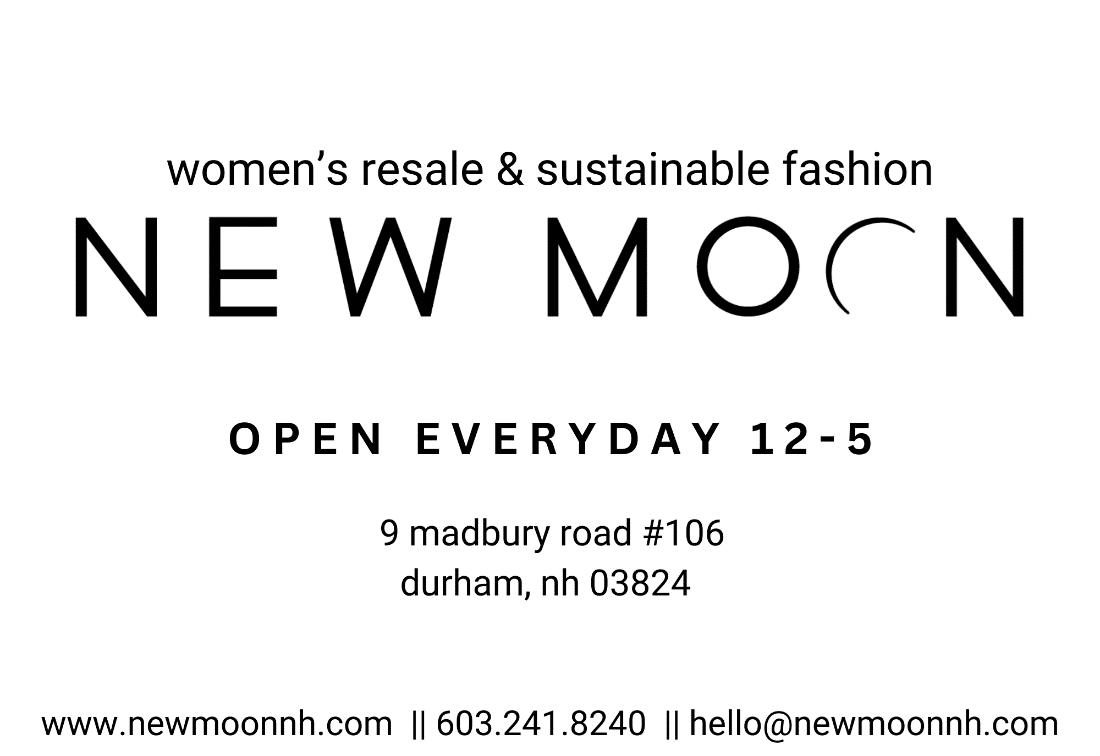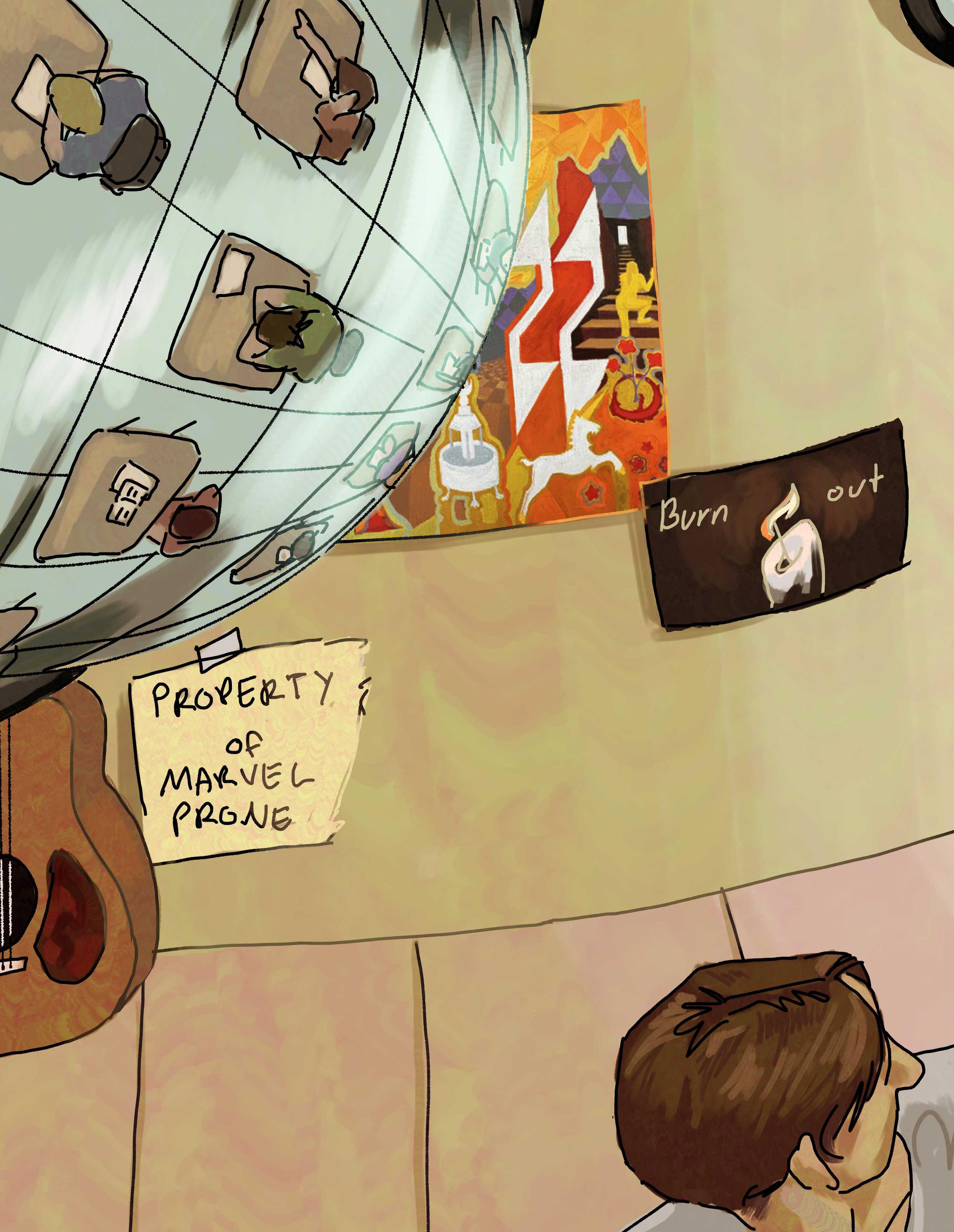








Hey MOR Readers,
We’re back at it with our final letter from the editor as Co Editor-and-Chiefs, and our final magazine as the 2023-2024 Mouth of the River staff. It’s a bittersweet moment that we find ourselves in while writing this letter.
Before we get any further, it feels important to note that you’re currently holding the New Hampshire Press Association’s first-place award winners for General Excellence in student journalism. As the student publication that has officially been dubbed the best in the state with award-winning writers, we are proud to present issue four.
However, this year our staff was more than award worthy – they were genuinely wonderful. They took risks as reporters, writers, and creators.
These risks include Delaney Nadeau’s cheating article, titled “It’s a Lot More Common Than People Think It is.” It required her to step outside of her comfort zone and took seven months of work before finally winding up in this issue. It’s also the partial inspiration behind student artist Maggie Fitzhenry’s cover design, in which students are seen cheating on both the back and the front.
When admiring Maggie’s talent, you should also keep your eyes peeled for the cover’s nods to other articles in the issue, like Amelia Rury’s in-depth profile on student band Limpin’ and James Li’s opinion piece on student burnout.
We want to thank all of the readers who find themselves holding this copy of Mouth of the River. This includes future staff, who we would like to tell: you’ve got it. Trust in yourself, and the power of your voice.
The work that goes into producing these pages is intense, but MOR’s work extends beyond the physical quarterly issues. That’s why we encourage you to check out or subscribe to our website, mor.news. It’s filled with time sensitive and multimedia work that shouldn’t be overlooked, including Hazel Stasko and Mia Boyd’s video honoring French teacher Barbara Milliken’s 31 years at ORCSD and her retirement this year.
Thank you so much for spending this past year with us! We appreciate all our readers and are excited about the opportunities and challenges that next year’s staff will take advantage of.
Hopefully you’ll catch the first issue of 24-25, where we’ll be joining you as readers.
Mia Boyd and Abby Owens mor.news




Mouth of the River



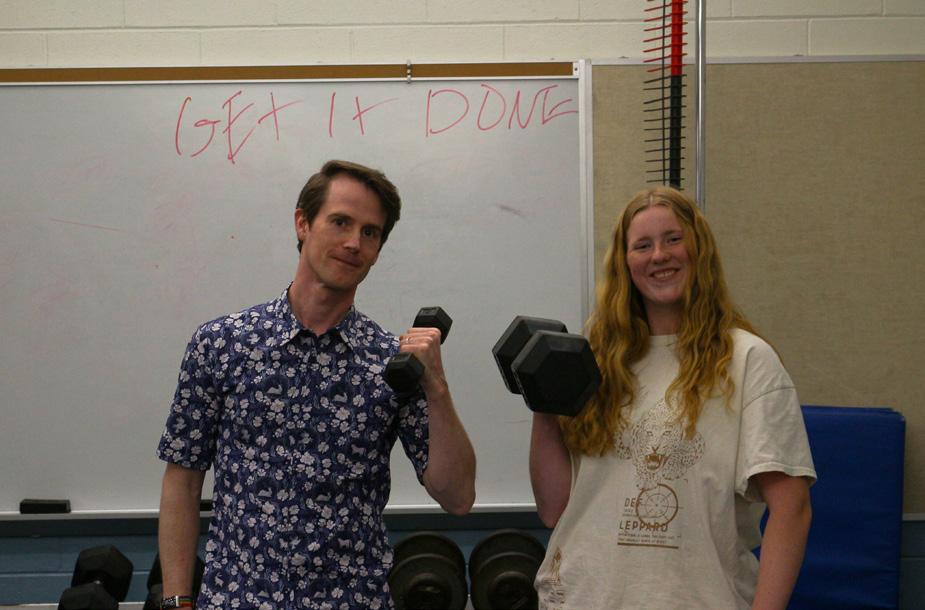
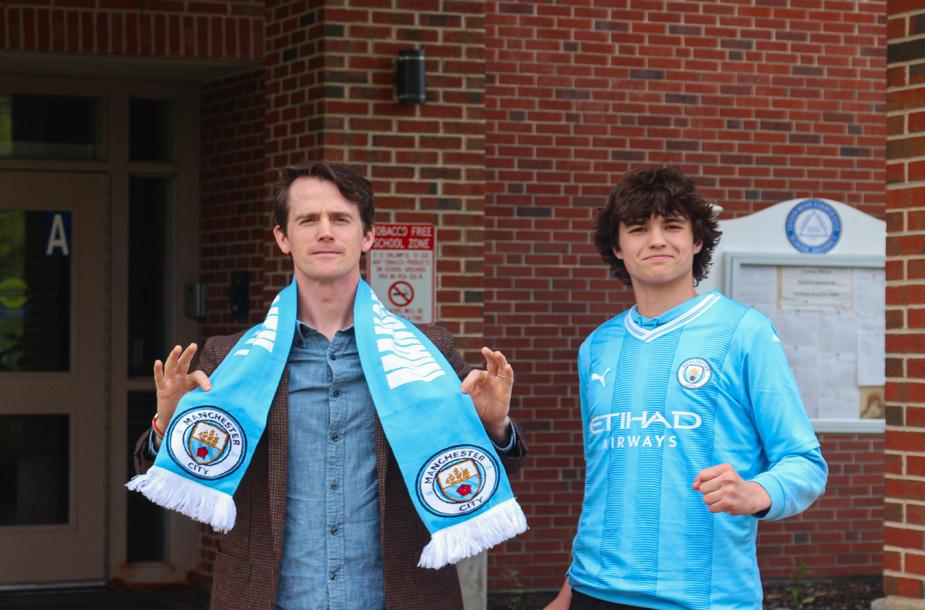
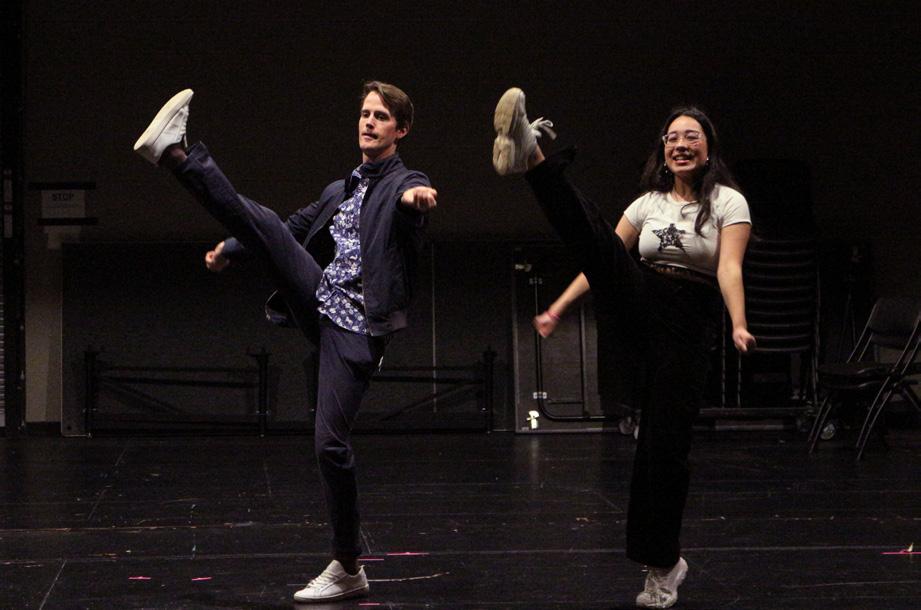
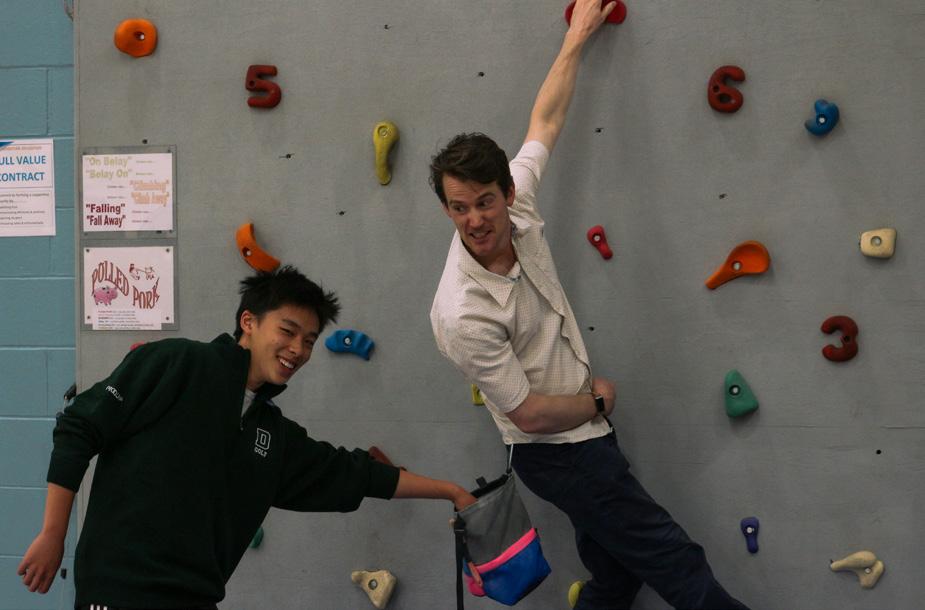


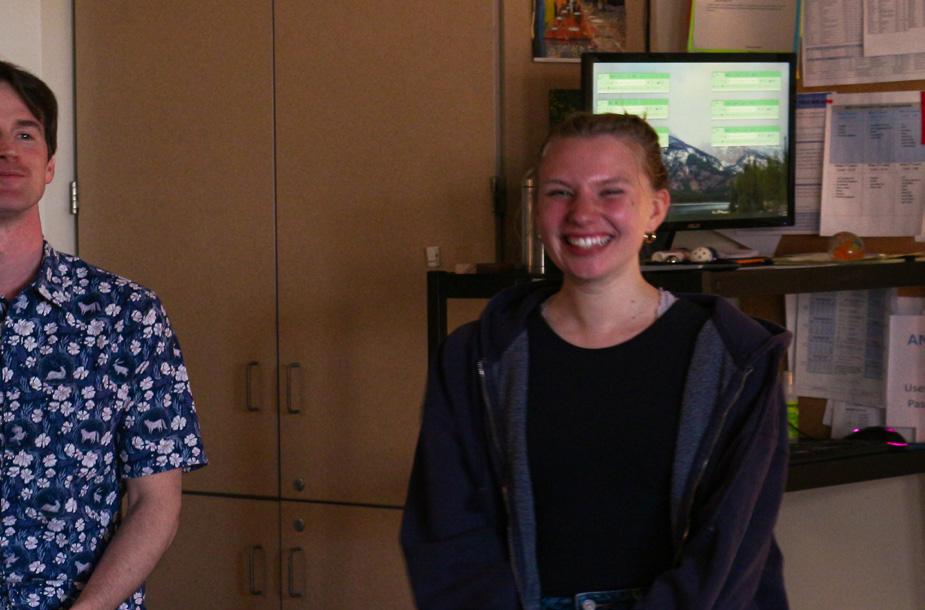
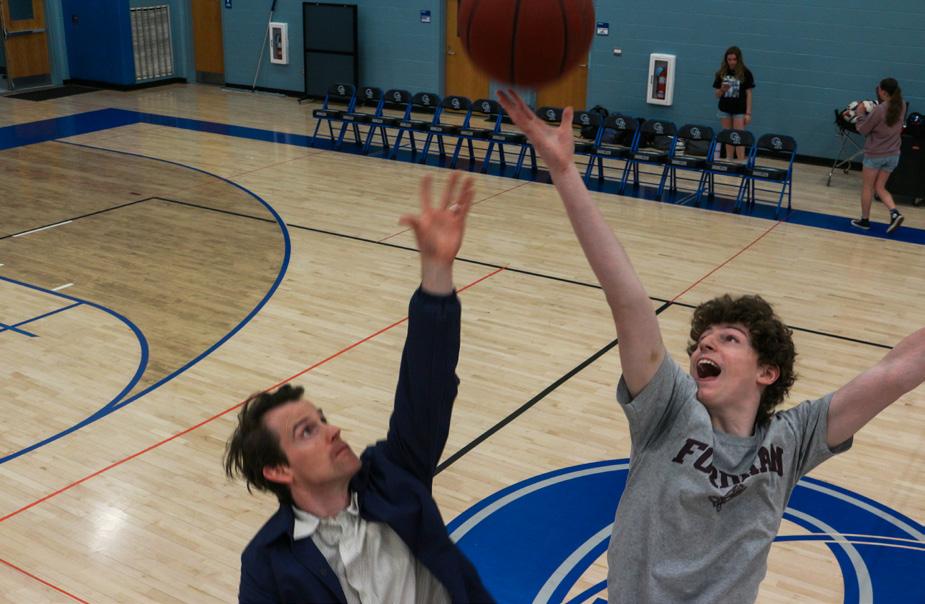
Mouth of the River Mission Statement
Mouth of the River seeks to reliably inform the student body, as well as the surrounding community, of interesting and newsworthy content in a modern, compelling format. Our goal as a staff is to give voice to the students of Oyster River, and have it heard by all our students. The opinions expressed in Mouth of the River represent those of the writers and staff.
“It’s a lot more common than people like to think it is.”

An exploration into the cheating culture of Oyster River High School
written
itting in the library on a quiet Monday morning in early December, I waited to interview Assistant Superintendent Suzanne Filippone about Oyster River’s cheating culture. My palms were sweating and my mind was racing a million miles a minute. I wasn’t sure how she was going to react to the information I was about to share. I didn’t expect the reaction I ended up getting, not because I didn’t think she would care, but because you would never quite expect to see that level of emotion from an administrator during the day.
Our conversation broke my heart bit by bit. It was difficult to see Filippone’s reactions. She grew emotional as I asked her questions and explained to her the scope of the “cheating culture” at ORHS. Even though I was doing the interview, she had questions for me. “What are those pressures and those expectations on you or that you’re putting on yourself?” she asked. She wanted to know, “[what is it that makes] the cost worth it?” Her raw shock spoke volumes.
In the seven months I’ve been attempting to answer the very questions Filippone asked that day, I have learned so much. There isn’t a student at ORHS who goes through their high school career without some level of awareness of the cheating that goes on here. However, these seven months have taught me the true scale and, perhaps more importantly, I’ve discovered how unaware many of the adults in the building are about what’s really happening—to the extent where one anonymous student said that, “teachers just don’t notice, or they really don’t care.”
“There’s always an argument to say that there’s only a couple of kids [cheating] and so the solution just needs to be targeted to those couple kids. But, in all three grades, I’ve seen cheating in every single one of those classes I’ve been in by all types of students,” an anonymous student, M, shared. He went on to list how he has seen cheating, “[ranging] from using previous years’ test answers, to stealing tests from teachers’ desks, to stealing midterms from teachers, to selling complete course curriculums of every single test from that year for money.”
M also highlighted an example of how students take advantage of their teachers’ mistakes, including “the majority of a class using a released test that the teacher released by accident,” and none of them thought to alert the teacher that this had happened. “We all just wanted to get the good grade.”
Through all of my conversations with students, I heard the same things countless times as examples of what cheating looks like at Oyster River, and I was constantly reminded that, here, cheating is not limited to copying the occasional Spanish homework—a measly formative grade—even though that’s the type of thing that happens most often.
Walking through the halls, surrounded by the echo of students asking one another “did you do the homework?” or “can I have the answers to last night’s assignment?” Answers to these questions range from “I was hoping you had them” to “they aren’t right, but you can have them.” To which students often respond, “they don’t need to be right. It just needs to look like
I tried.”
A scene all too familiar to ORHS students. It begins with the simple request to copy one’s homework, morphs into the constant questions of how you did on a test, what grade you got on a project, what your GPA is, etc. From there, many students find themselves engulfed in this culture.
When an anonymous student, C, was asked if she had ever cheated academically, she responded, “oh 100%!” I asked immediately what her preferred method of cheating was, hoping it would give me some insight into what type of things she’d cheated on, to which she responded, “just having paper with me that’s under my test or something.”
Students might begin by cheating on homework because they’re stressed, or because it’s easy and they feel like they can, which then can lead to higher stakes cheating when students feel they don’t know the material or are pressured to achieve a certain grade. And the cycle only continues.
Many think of “cheaters” as those who don’t care about school or are too lazy to put in the work but that’s not always the case. Here, as in any school, there are students who fit that stereotypical perception but here there’s also the students who care so much about their grades and being successful.
When asked why she thinks people cheat, ORHS Principal Rebecca Noe said, simply, “Nerves. Fear. Pressure.” She paused, and I could see her thinking before she continued, “I think honestly, pressure.”
Noe reflected on her experiences as both a teacher and an administrator dealing with and investigating instances of cheating. She explains that, “the stereotype is that it’s going to be a certain type of student or kid, and a lot of times it’s actually the people who have A-pluses or are on the honor role.” She went on to say that oftentimes for these students it happens because of the academic pressure they’re under.
This issue stems from a variety of factors but is largely fueled by the culture of ORHS. At Oyster River, there are types of cheating that many students wouldn’t even qualify as cheating. Asking what material was on a test or for the homework answers, while technically cheating, is something that happens constantly here. Students add fuel to the fire as they warp the definitions of cheating in order to excuse these behaviors, and other students succumb to the pressure of their peers, making it into a culture.
Throughout my reporting, a sentiment that was repeated by both students and the occasional faculty member was the idea that they wouldn’t be surprised if cheating was happening in some capacity on almost every assignment in the building.
Cheating as a concept has a vast realm of applications and meanings. To effectively understand that, I figured the best place to start would be the Oyster River High School Student Handbook. The handbook begins the Academic Integrity section by stating, “In support of Oyster River High School’s mission to become a community of educated, ethical, and responsible cit-
izens, this section outlines the standards for academic integrity to which we hold ourselves.” This section of the handbook is broken into two parts: Plagiarism, and AI Writing Generators. The handbook emphasizes the importance of students doing their own work and ensuring they give credit to the work of others.
“Nerves.
either having attended college, teaching/working in the education field, or simply understanding the importance of education and wanting the best for their children. With that, there’s a sense of pressure on Oyster River as a district to educate students in the best possible ways and to help students be as successful as possible through receiving high grades, getting into esteemed
The section of the handbook was understandable, but it was also so vague and unspecific that it left me unsatisfied. So, I asked every single source I spoke to how they defined cheating. I was overwhelmed with a variety of definitions ranging from simply breaking the rules or getting answers ahead of time, to the more expansive definition coming from anonymous student, B, “giving yourself an advantage that isn’t readily available.”
Faculty also shared a range of definitions including math teacher Peter Harwood’s, “unauthorized aid.” Filippone initially bounced around the word “dishonesty” before settling on the definition of “claiming something [as] yours that is not yours.” Filippone went on to highlight why cheating is wrong saying, “when you cheat, you cheat yourself, and [most] people will feel like they’re wronging themselves. I think that most people know and understand when they’re cheating, they’re doing something they shouldn’t be doing, and I think that that can have a negative impact on the individual or the person.”
Regardless of how students define cheating, it’s obvious to students that cheating happens all the time on regular class assignments and tests. However, sometimes the cheating is crystal clear. Through my conversations with sources, I discovered how far it spreads beyond just those class assignments to cheating on national exams.
At ORHS cheating has become normal, and there are students who rely on that sense of normality and continue cheating on their AP tests. They change their seats, have their phones
colleges and universities, and going on to good jobs. That pressure creates a certain expectation for students to perform and be “successful.”
These pressures and expectations have drastic impacts on students making them feel as though the most important thing is the grade and takes the importance away from learning as a whole concept.
Student W reflected on the scope of cheating saying, “I know people getting into really good schools that have cheated their entire way through.”
Student M shared a detail that perfectly follows W’s thoughts, saying, “I personally know someone who got a spot for the same exact major, college, and scholarship that two qualified people applied for, and the cheater got the spot.”
W continued her earlier thought saying, “Why wouldn’t you cheat at Oyster River if you’re not going to be punished for it but rather move ahead in life?”
M’s and W’s thoughts here tie to the exact reasons why a cheating culture is so dangerous. When cheaters aren’t punished, the non-cheaters end up feeling the brunt of the toxicity of this culture.
I have tried to remain objective in my reporting of this story, however I know this toxic feeling all too well. Last year, I was in a class where I later found out that a large portion of the class had been consistently cheating on tests and earning near-perfect grades. This was an extremely frustrating thing to
“I know people getting into really good schools that have cheated their entire way through.”
with them, and work with their peers in order to get the best score by any means necessary. Anonymous student L reflected on their AP test cheating experience saying, “I’d cheat a million times to avoid taking that class in college.”
How did we get here? Why is this an issue? How does the community play into this?
We are surrounded by higher education. UNH is in our backyard, and many families have some relation to higher education,
find out for multiple reasons. I’d put in so much work trying to learn and understand the content while many of my classmates were just cheating their way through. I understand the pressures these students were feeling that pushed them to cheat but I was dealing with those same pressures and didn’t go down that path. Seeing my peers repeat these habits daily became increasingly frustrating as time wore on.
What type of students are affected by this cheating culture?
At ORHS cheating seems to be coming from many “smart” students who are expected to perform well and get good grades.
“It’s all high-level classes, these are all AP classes, the students who are doing this are in the top-10 of Oyster River every year,” M claims.
Student W gives insight into the rationale from a “high performing” student. “The way I think about it is the college that I’m going to, and what I want to work towards, doesn’t have to do with any of the classes that I would be cheating in, and that’s how I’ve justified it. But also, it’s honestly just really true.” W acknowledged the lack of popularity among faculty for this opinion continuing, “When will I ever need these things in my life ever?”
This leads to a deeper question: What parts of our culture promote these behaviors?
An anonymous student, X, thinks it’s bigger than just Oyster River. “[That’s the] culture of the world and academics right now.” He continued by speaking about the perception of how much harder it is to get into college and the idea of grade inflation, and the pressures that these things put on students.
Most of the students I spoke with highlighted that what has led them, or their peers, to cheat is that they are experiencing this intense pressure to be successful, and the emphasis is on that rather than the importance of learning the material.
ORHS Writing Center Coordinator, Jake Baver, was able to provide a unique perspective given that he attended Oyster River High School and has seen the pressures put on students and continues to see those pressures in his current position. Baver highlighted the idea that ORHS has “always had a reputation for being the public high school in New Hampshire that churned out top level graduates that would then go on to do excellent things in college and beyond.” Baver continued by saying that he thinks “that’s a dangerous reputation to try to uphold because it emphasizes excellence at the expense of the general population’s wellbeing at times.”
Oyster River High School, according to US News and World Reports, is currently ranked as the 5th best high school in New Hampshire. “We used to rank better nationally,” according to Baver, which plays into the pressures put on ORHS students to perform.
In a Newsweek Top School ranking from 2013, Oyster River High School was ranked 753rd in the country and second for New Hampshire. A Foster’s Daily Democrat article from the time quoted Amanda Martin, who spoke about the effect that teachers had on ORHS receiving this ranking, saying “I think they push us because they see your potential.”
Former Principal Todd Allen reflected on the school’s ranking in the same article saying, “our kids definitely come through here and graduate with a plan. I think that’s largely what’s demonstrated through the ranking.”
While the ranking itself may not be a driving factor, it plays into the expectations of what Oyster River stands for and what students are supposed to accomplish. This plan that Allen talks about begs the question: who comes up with these plans? Oftentimes the plans are curated by parents and families, not by the individual students, and that’s a large portion of the problem. Students need to be able to come up with what they want to do with their lives and how they

want to use their education. By preventing students from doing this for themselves they begin to do anything in order to meet the expectations put on them, even if that means cheating.
So, what is the next step?
I’ve been working on this story since mid-November of 2023, and when I started writing I knew that cheating was happening but not quite how to feel about it. Before thinking of this as an article I was frustrated with the kids who were cheating because it felt like the hard work that I’d been putting in was being invalidated. I then went through a phase of being so overprotective of the students because they were under all of these external pressures. It wasn’t until my final conversations about the story with Mr. Kelly that I realized the truth. The students aren’t victims or villains. Yes, they’ve done something wrong by cheating but the point of this story isn’t to punish them. The goal is to begin a conversation about our cheating culture.
Faculty doesn’t understand the extent to which this is happening, students don’t feel like they’re doing anything wrong because they’re all doing it, and outside of the building people don’t see what’s going on. So, the first step in creating a solution is having a clear path of communication between students, faculty, and families. We need to feel comfortable talking about the pressures students experience, and the expectations of the people around them.
However, there isn’t just one solution. We need to reduce the emphasis placed on receiving high grades by fully committing to competency-based grading. We also need to change the competitive mindset around academics by ending the conversations around how we did on a given assignment. Additionally, we need to be better at catching cheating when it happens and ensuring that there are clear and consistent consequences. If we all take on these things collectively, we can begin to change this culture.
As the school year's final buzzer is approaching, it's time to look back at the Oyster River High School (ORHS) sports teams whose final buzzer meant victory. Volleyball, girls cross country, boys ice hockey, and girls' indoor track all had the honor of representing their school’s name in the best way possible, 2023-24 State Champions. written by KEVIN
KELL
*At the time of writing this, the spring season has not finished so I apologize if there is a team I miss because of this.*
Expectations were sky high this year as it’s been nothing but success in the past for the ORHS girls cross-country team. “We won states my freshman year, and then we were second sophomore year,” said star runner Mackenzie Cook (‘25). “We definitely wanted to come back and win it.”
The season kicked off about as good as they could have hoped, winning the Bobcat Invitational with a combined score of 27, almost 90 points less than Bedford who finished second (lowest score wins).
The smooth sailing continued the further the season went. They won the Manchester Invitational with a score of 47, the Black Bear Invitational with a score of 55, and then completed the “pre-state meets” undefeated by winning Battle of the Border in Alvrine with a score of 52.
While this season may seem too good to be true, it in fact was just about perfect. “There were no major setbacks,” said Cook. “Being undefeated in New Hampshire is a pretty big thing, and it’s pretty impressive.”
Going into the state meet, individual preparation was important, but the team seemed to prioritize preparing as a team. They understood that the state meet brings more nerves than any other meet and to counter them, the seven varsity runners decided to take them on together. They became more of a team who all focused on the same common goal.
The state meet went just as smoothly as every other meet. The team put up their second lowest score all year with an eye opening 29. “It was a really fun race,” said Cook. “It was a very hot day and there was a lot of stress around that, so the result was such a relief.” ORHS had 5 runners finish top 10. Cook finished second with time of 19:06, Haley Kavanagh (‘25) finished fourth with a time of 19:30, Haley Bezanson (‘27) finished sixth with a time of 19:43, Neely Roy (‘26) finished seventh with a time of 19:46, and Madelyn Cook finished tenth with a time of 20:45. The other two runners also had a phenomenal race, both placing top 30 out of the 110 runners.


Before the season even started, there were high expectations for the Bobcats, said returning Capitan Cam Miner (‘24). “I knew we were going to have a great team this year. We all knew that we would have a solid shot at it this year.”
The season kicked off great for the ORHS boys’ hockey team, beating last year’s champion Dover in the opening before falling to Winnacunnet at home. After this, they went six straight without defeat before losing two straight. “It definitely knocked some sense into us,” said star forward Camden Beaupre (‘24).
After this road bump, the team made some major changes. “[The losses] were tough. The other captains and I approached the coaches and told them what the team was thinking, and I think that really seemed to work,” said Miner. After these changes, the team never lost again for the rest of the regular season.
Going into the playoffs full of momentum, the Bobcats were ranked second, and were set to play Goffstown in the quarterfinals. After beating them 4-2, they were set to play in their fifth semifinal in five years. But for the first time in those four years, they won, beating Alvirne-Milford in an exciting 4-0 rout and were set to play Spaulding in the championship.
Going into the state championship, the team found themselves in uncharted waters with none of the players ever being there before. “We wanted to treat it exactly like any other game.” said Miner. “It was obviously a little hard because none of us had experienced this.”
This mindset clearly worked as less than a minute after the puck drop, Beaupre found Braiden Moriarty (‘26) who made it 1-0. “It was great to get the lead early. It shifts the tone of any game,” said Beaupre. After this, with stellar goaltending from Cole Harwood (‘25), and goals from Miner and Sawyer Levesque (‘25), for the first time in ORHS history, they were state champions.
“The key thing for our team was that everyone bought into the system instead of playing as individuals,” said Beaupre.
This team was yet another team who started the season with high expectations. Similarly to the girls’ volleyball team, the girls indoor track and field team were looking to repeat as state champions, as last year, beating out Newmarket by a slim 2.5 points to win the state meet.
The season opened with a small meet at Phillips Exeter Academy, where they tied for first place. But that was never really the goal. “It was just about getting the rust off, and also performing as best as we can individually to start the year,” said Erin Carty (‘24).
After starting the year off hot, the team cooled down a bit, finishing in sixth place in the next meet, followed by two fourth-place finishes. The final three meets before weren’t scored but even though they never won as a team there were some signs of promise. This included Carty consistently finishing top two in 55-meter hurdles, Makenzie Cook and Kavanagh dominating in a variety of individual runs, and the relay team doing well no matter who was running.
To prepare for the state meet, the team focused mainly on finetuning their fundamentals. “It was a lot of skill days where we were focusing on our individual events,” said Carty. “We didn’t do anything big to make sure no one was sore or tired.”
The state meet couldn’t have gone any better for the ORHS girls indoor track team as they put up a score of 100, over 60 points more than second place Kearsarge and almost double the score they put up at the previous year’s state meet (highest score wins). Individually, Carty won the 55-meter hurdle and finished second in the 300-meter, Kavanagh won the 1500-meter, and Cook won the 3000-meter and finished second in the 1500. The 4 x 200 relay team came in second, and the 4 x 400 and 4 x 800 relay teams finished first. Other impressive finishes were Madelyn Cook and Bezanson finishing third and fifth respectively in the 1500-meter, Roy finishing fourth in the 3000-meter, Avery Baumgardt (‘26) finishing third in long jump, and Talia Banafato finishing fifth in the 1000-meter.


With the 2022-23 girls’ volleyball team winning the state championship, they entered the 2023-24 season looking like the team to beat. But the team understood that going back-toback would be no easy task. “[winning the championship last year] didn’t really have any impact on us,” said Captain Emilia Cavicchi (‘24). “We lost some important players who graduated so we had to start fresh.”
The season started with a bang when they defeatied Winnisquam 3-1, which they followed up by thrashing rival Saint Thomas 3-0. “It really hyped us up because Saint Thomas is one of our rivals and one of the better teams we were set to play,” said Cavicchi.
Defeating teams became clockwork for the team as they rode out the regular season going undefeated. All this time they managed to only lose four sets out of the 52 that they played throughout the season. But they stayed disciplined, even having the mentality that four sets dropped was still too many and that they shouldn’t be dropping sets at all.
They were obviously the team to beat as playoffs came around. The ORHS girls’ volleyball team was the top seed and received a first-round bye into the Quarterfinal. They ended up playing Saint Thomas, and just like they did earlier in the year, they shutout Saint Thomas and readily continued on to the semifinals. In the semis, they met Campbell who carried an impressive 11-3 record going into the playoffs. But just like the Saint Thomas game, the Bobcats shut Campbell down, swiftly winning 3-0.
The finals were set, Oyster River vs Coe Brown. Not just a rivalry, but also a rematch of last year’s finals. “Coe Brown was our biggest competitor this year by far. So, it was definitely a lot of nerves,” said Cavicchi. The two teams met once in the regular season, and it ended in a 3-0 Bobcats win.
This time around, it wasn’t as easy. The Bobcats found themselves in the fifth set for the first time all year. “We tried to persevere because we had never been [in the fifth set] as a team,” said Cavicchi. The Bobcats battled through and emerged as back-to-back state champions.
There are multiple strong spring sports teams that hope to make a run for a state championship, but because I’m writing this mid-season, all I can do is wish them good luck!

A class at Oyster River High School explores the relevance of genocide in the modern world.
written by HANNAH KLAROV
Iwas sitting in the counselor’s office, amid my new schedule for junior year. I was taking a long time, trying to figure out what I should fill my unwanted free period with. And, on a whim, I picked Genocide in the Modern World. Yikes,that’sagruesomeclasstitle, I thought to myself.
But through taking that class, I’ve realized that the most gruesome moments in history are the ones worth learning about.
Through discussion and student-led lessons, Genocide in the Modern World makes it apparent that genocide is not a thing of the past by opening up the conversation around it.
Whenever I bring up the class in a conversation, I swear I’ve lost count of how many weird and concerned looks I get.
In April, the class chose to go on a field trip to the Auschwitz Exhibit in Boston and in May we taught 8th graders at Oyster River Middle School about genocide and the different topics surrounding it. Each time I told people around me about these events, their face automatically drops.
In their defense, genocide isn’t really something
that everyone just brings up in a normal conversation. But, with the multiple humanitarian conflicts that are happening in the world as we speak, it should at least be considered as something to process, maybe even out loud.
Genocide isn’t only something that happened in the last century, it’s happening now.
Miles Gans (‘24) a student in my class, has observed that the more time we spend in this class, talking about genocide, the less taboo it becomes. “Because it’s dealt with sensitively and all of us are so used to talking about it, it’s just another topic we’re talking about, rather than it being something people would rather not touch on at all.”
Having this opportunity to be able to talk to other people about genocide in a way that can be done freely, while not being insensitive, is what makes Genocide in the Modern World stand out. I remember in past history classes, when we would go over the Holocaust unit, our teacher would try to start a discussion, but either nobody would be comfortable talking because of the seriousness of the topic, or people would treat it as a joke.
Lily Pappajohn (‘26), another student in the class, thinks that the people in the class really drive the class to its core. She says, “Everybody’s taking it seriously, which really helps...we want to learn about the topic. We wouldn’t have taken the class otherwise. So sometimes, it is hard to talk about it, but we’re still able to learn from each other.”
A way to learn from each other can be through making the curriculum of the class student-led. Gabrielle Anderson, a social studies teacher at Oyster River High School (ORHS) and the teacher of Geno-
ings, who were taken away from their families, from who they were before, still deserve to be remembered just as much as Holocaust victims.
Anderson realizes this and tries to get students to learn about how these acts can take place in the modern world. “It’s really important for students to learn about [genocide], especially with...still a lot of modern stuff that’s happening that students may not know about. Understanding the patterns behind genocide and the why’s can point to how it can be prevented.”
Altough a class can’t singlehandedly prevent a geno-
“I had a vision of what I wanted [the class] to be. And then you have the students, and that vision often changes for the better.” ***
-Gabrielle Anderson, ORHS social studies teacher
cide in the Modern World, made this class be more seminar-focused and student-led to better push her students.
She says, “I had a vision of what I wanted [the class] to be. And then you have the students, and that vision often changes for the better.” Along with informing her students about genocide, she makes sure that they are as equally interested in the lesson plan as she is.
Gans has seen himself become a better and more involved student in the class because of the focus on student involvement. “It’s more student focused and more what people actually want as a collective than what the teacher wants to teach us, I think that’s valuable.”
In our class, making our curriculum student-led means that students have more space to explore what we want to learn with input from our teacher. For example, when we first started learning about the Cambodian genocide, we first learned the very basics: the who, the what, and the when. But for our project, we branched off into answering a question out of the 10 or so questions that the class came up with.
That way, we made lessons so that each question on that board was answered and cover all curiosities about the genocide, because most of us haven’t heard that much about the Cambodian genocide.
Learning about genocides and humanitarian conflicts that weren’t the most covered back then, or even now, makes us better aware of the world around us. Those people that passed away because of mass kill-
cide or humanitarian crisis, we have already prevented one thing: silence.
Because after all, silence was what caused these genocides to be a part of our history books in the first place.


written by JAMES LI
t’s 7 pm on a weekday. I’m practicing a part which I had kept messing up, getting more and more frustrated with each repetition. My fingers slip. I mess up again. It was the last straw: I furiously pound the piano, with hatred swelling inside me. In that moment, I felt like giving up, never to play the piano again.
Whether it’s academics, sports, or a hobby, stress can often be a common occurrence, especially in competitive environments. For a lot of people, this stress can help them become more focused on what they’re doing. But it can also overwhelm them and lead to burnout, or mental and physical exhaustion. However, there are many ways to enjoy a hobby without overworking yourself, but also doing enough to feel accomplished.
For me (and probably many), my burnout moment was with competing. In middle school, I did a couple piano competitions. Although I didn’t do terribly, I did not enjoy the leadup to the competition. It usually involved months of practicing the same song for an hour and a half a day, even during school days.
My enjoyment of piano was already declining, with the breaking point started around the pandemic, when all in-person competitions were cancelled. Although I tried going virtual, it was so much more work that I didn’t want to do. After years of working towards competitions, I eventually got to a point where I wasn’t really practicing for anything.
Although it wasn’t the end of the world, I might have treated it like it was back then. At the time, I had been playing piano for 7-8 years, and the lack of perceived progress made me feel like I had essentially quit playing. I had stopped taking lessons, all the new pieces I started stalled out, and I didn’t feel inspired to keep going.
Another person who experienced this was Tyler Flynn (‘24), who has been playing soccer for club and ORHS for six years. However, during his junior year, he felt burnt out for the first time. “During the summer, I had my first job, and I was working 40-hour weeks. I was trying to study for the SAT, and then I was doing soccer. Soccer just became less of a priority for me. I started getting worse at it, I didn’t make varsity, I wasn’t enjoying it, and I was always out of energy,” he said.
It’s not uncommon to see this happen to student athletes or people who are serious about a hobby. We all know someone who has given up on something due to overwork and stress. In fact, 30% of female and 25% of male college student athletes experience burnout, according to “The American College of Sports Medicine Statement on Mental Health Challenges for Athletes” from The American College of Sports Medicine.
It might be hard to realign with something you may have hated doing, and that’s okay. “Mental and physical health are more important than putting something on a resume,” said Grace Kasper (‘25), who found herself burnt out after being a part of way too many extracurricular activities at school.
“I dance, I’m on the dance team, I teach dance at a local
studio, and then I’m also with the prom committee, Girl Scouts, and all these things other than dance. It’s sometimes difficult to balance everything,” she explained.
During high stress periods of your life, it’s best to address both mental and physical health. “I try my best to practice good self-care, like making sure that I’m drinking enough water, eating enough food, and trying to keep myself healthy,” she says. “I’m also trying to find specific times built into my schedule that I can just sit at home and do nothing. As much as that sounds like it’s not productive, it’s still vital and needed.”
I did not do this. I sort of treated piano as a job rather than a hobby, and I would constantly grind almost every day of the week. Because of the constant repetition, I grew to resent playing, just like someone could resent going to an office job. However, after one certain competition, I decided to stop playing. It was weird because it was such a big part of my life which just suddenly became empty, but it helped me rekindle my joy of playing.
After my hiatus from piano, I decided to focus less on competitions. Rather, I started focusing on playing piano for others, like doing concerts at churches and community centers, and teaching piano. I would consider it less work than competing, but I would also receive the same if not even more enjoyment from performing and teaching.
For Flynn, it meant challenging himself more. “I think when it started feeling normal again was when I switched clubs. I went from one of the senior players and starting every game and playing every minute, to not being a guaranteed starter on the new club – everything was at a higher level. In a weird way, I think I burned out because I wasn’t being challenged, and I got bored of myself and let all that deteriorate,” he said.
Additionally, he saw that the players and coaches were always working together to reach their goals and felt like that helped him become more involved in soccer again. “[To reduce burnout], you’ve got to be in the right ecosystem so that you’re being supported. Working towards something as a team definitely helps,” he said.
Thankfully, I had my family to back me up when I was feeling burnt out. They encouraged me not to quit but understood why I took some time off to get back the motivation to play again. They also helped me come up with the idea of playing at churches and nursing homes. It’s really important to have someone to back you up when you feel like giving up. “The way you fight burnout is always taking the next step. If you can’t take the next step, you get supported – you don’t keep tumbling down,” says Flynn.
If you feel burnt out, change the level of intensity you’re working at. Challenge yourself, or ease off the gas. Don’t keep festering in an environment which drains your energy. Get some good support from friends, family, and anyone you trust.
It’s now 5pm on a Saturday. I’m practicing pieces I’ve known for years, reminiscing about memories associated with them. My fingers slip. I mess up. But I don’t care. It’s just fun to go back and play again.






the 90s the 00s



The MORgue is now digital (and accesible with ORCSD wifi)!! Follow these QR codes to look into different decards of the Oyster River community through the eyes of the students.









A decade later, this former ORHS band is still producing original music, and have been featured on 92.5 FM The River Boston.
written by MICAH BESSETTE photos courtesy of RAINOR VIGNEAULT
’m in a band called Tedious, and as soon as we formed, we decided we were going to break up after high school. How could a small high school band ever make it work after graduation?
Marvel Prone is an indie rock band that started performing in 2014 at Oyster River High School (ORHS). Although many of the original members have left, the band has been playing ever since.
Growing up, I always watched Marvel Prone at local open mics, so I wanted to learn more about their history and how their leader Rainor Vigneault, the only consistent member, has kept the band alive.
actually the one who came up with it. It means something like being drawn to beauty and mystery at your own expense. It felt like a cool oxymoron,” said Vigneault.
The band name is what holds the
Marvel Prone started to change when Donovan decided to leave. “Things were moving in a different direction than I had envisioned, so I left to start my own band,” said Donovan, who has since rejoined.


Marvel Prone started as most bands do, a few musically talented friends getting together to have fun. Originally consisting of Vigneault, Emily Donovan, Reilly Webb, Peter Dubois, and Bailey Weakley, Marvel Prone got their roots practicing in Vigneault’s dad’s basement and performing at ORHS Coffee Houses. “It was a super cool atmosphere, and it was special to perform exclusively for kids our age,” said Vigneault.
At that time the band was called DAVE, after a joke made by Webb, before being changed to Marvel Prone a little under a year later. “My mom was
group together. I remember struggling to come up with a name with the other members of Tedious, but when we eventually got there, we knew the band would work out, at least for a little while.
Soon after Donovan left, the band decided to record and release their first original, Nocturnal Life. “We submitted it to a regional high school songwriting contest, placed top ten, and had it aired on 92.5 FM The River Boston.”
Releasing original music can immortalize a band, and I hope to one day with the rest of Tedious. Having music recorded and released means even if the band does break up, the music can still float around in the cosmos of the internet.
After graduation, Dubois left for college and only three of the original members remained. “I decided to keep the band going strong with Bailey and Reilly. I took a gap year to work and to finish recording an album with the band. We released the album Moonlightning in 2016 just around the time I started my freshman year at UNH,” said Vigneault.
During their time at UNH, the band performed mostly at local venues and house parties, which according to Donovan are always the best shows. “We played most of our shows at ven-

ues like The Stone Church in Newmarket, The Freedom Cafe, the WSCA Radio Station Button Factory stage in Portsmouth, and a smattering of other gigs across the seacoast NH area,” explains Vigneault. “In more recent years we’ve ventured to Boston quite a few times, playing at popular venues such as The Middle East and O’Brien’s pub.”
Through constant iterations, Vigneault has managed to continue the legacy of Marvel Prone. “I’ve kept the band alive by playing with whoever wants to play with me. I’ve always had a wealth of incredibly talented friends to reach out to.”
The band’s most recent album, 11:22, is the most monumental achievement of Marvel Prone thus far, says Vigneault. “We recorded 11:22 in Chicago at Electrical Audio Studio with legendary
sound engineer Steve Albini, who’s best known for his work recording The Pixies’ Surfer Rosa and Nirvana’s In Utero. That is by far the biggest highlight for Marvel Prone to date.”
Any band or artist who’s been performing for as long as Marvel Prone is bound to have lost inspiration at some point, according to Donovan, and she has figured out a remedy. “Sometimes it means you need to make some changes, whether that be in members, sound, or something else, and sometimes it means you need to start looking at the world through a different lens to find inspiration again.”
Ten years is a long time for a high school band to be around, but with the current lineup of Vigneault, Donovan, Madison Russo, and Matthew Bicker-
staff, the fire of Marvel Prone is burning bright. “I’m hoping to play a lot more shows in Boston; we’ve met some really cool bands down there. I also want to experiment with different styles of music in our future projects.”
Recently, the band has been working on writing and recording demos and hopes to release an album by the end of the year. According to Donovan, the future of Marvel Prone is looking up. Her final advice to high school students, even if it doesn’t work out in the end: “learn an instrument and start a band with your best friends, you won’t regret it!”
How one student is bringing funk back to ORHS, one coffeehouse performance at a time.
written by AMELIA RURY
Tplain cotton t-shirt. The shirt was worn by Levi Brandt (‘25) the first time he performed his original music at Mouth of the River’s Winter 2024 coffeehouse, joined by three Oyster River High School (ORHS) graduates.
The first performance of newly established band, Limpin and the Implements, made a memorable appearance for the entire coffeehouse audience. “I was the coolest guy ever, for like a week,” said Brandt.
The audience raised questions about the creation of the band, how some of the members had not set foot in ORHS for four years, where the intriguing sounds and lyrics came from that coffeehouse had previously been missing. To find the an swers to all these, the recent history of one man comes to light.

Brandt, under the alias Limpin, had been writing music for over two years by the time of this performance. “Most of it was garbage. After a while, it started to sound a lot better, and
Implementing anyone into a band for the first time in front of an audience, especially original songs, is no easy feat. Each of the four members are talented musicians individually, but
they fit together in a unique way that had ears perking up during the first notes played. “They have a pretty jam-bandy background, which lends a lot of subtle funk. I feel like there’s not enough funky coffeehouse. There’s been a funk drought. We’re bringing that back,” said Limpin.
Brandt (’20), Colin Flores (’20), and Liam Weglarz (’20), played coffeehouses together as students. “We got together to jam, have fun, and mess around,” said Weglarz. While they had met up since graduating, they hadn’t stepped in front of an audience with their instruments as a group for the past four years.
“We talked before the first coffeehouse of the year, but never put anything together. In February, we really locked in, put a setlist together, and just went for it,” said Brandt, who plays the bass behind his younger brother.
Bringing a different sound to coffeehouse is why Limpin and the Implements were so well received during their first two performances. Flores said, “Putting together a solid setlist is having varied sound, some that’s a little funky, some that rocks a little. With our last set, we opened with a hard hitting, rock driven song, ‘I Ask You This,’ and then followed it up with ‘Feel Good Inc.,’ which is just total funk, and then closed it out with a little bit more chill and darker song.”
With such an ambitious setlist, the band knows they have to nail the sounds to get the desired effect. “Whenever we get into the studio, we’re all locked in and laser focused,” said Limpin. They know how important this focus is, especially since they only have around two or three practices as a group before each coffeehouse.
“It’s about tuning in on each song when you rehearse. You want to get solid takes of all the songs in consecutive order, back-to-back, until you feel really good about it,” said Brandt. He said the biggest piece of advice, from the kickstart band with a new set of eyes on them, is to, “practice up and lock in as hard as you can.”
ble parts about their performances.
“Recently, I made a huge train wreck an EP where I played all of the instruments. People think it’s good, but I think it’s terrible,” said Limpin. Even without feeling totally confident in all the music he was releasing, Limpin knows he creates captivating performances. He continued, saying, “I realized people enjoy my music more when it’s live.” ‘
Besides crafting his own performance, Limpin kept the eyes on him during the quarter 3 coffeehouse, when he made an appearance with rap group Chris and Koushik. He had previously created a sense of competition, and this feature only furthered the discussions surrounding controversy between the two groups. He said, “I dissed them in my first set, now I’m on a sworn journey to erase them… I made them think I was on their side, but really it’s all just one big manipulation. Part of my master plan.”
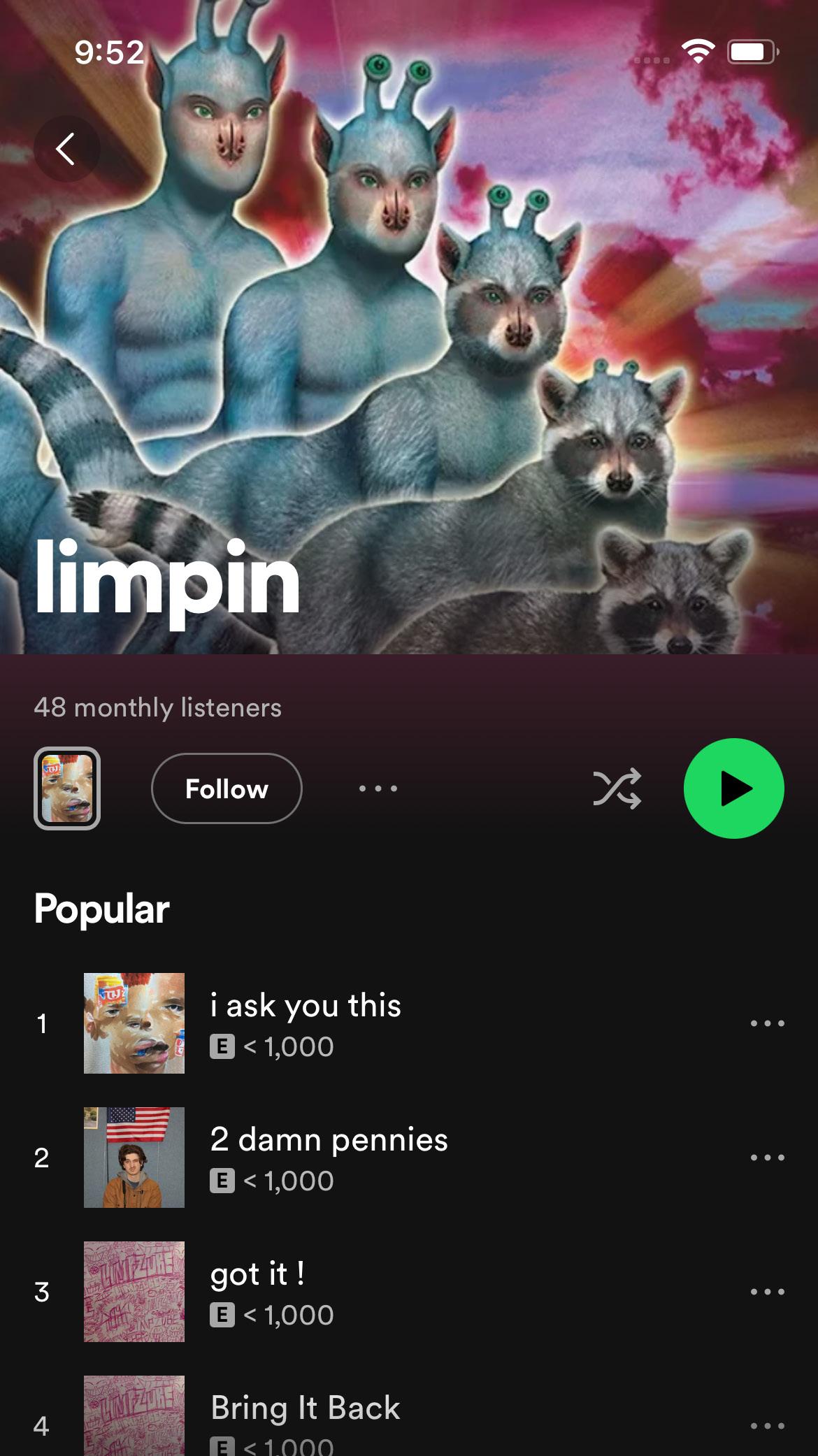
While they may be serious about these limited rehearsals, the band still has fun collaborating and bouncing ideas off of each other. “We all listen through albums and pick out songs, anyone can really throw out a song, and if we want to play it, we’ll play,” said Weglarz.
Limpin and the Implements don’t just play covers, as Limpin has been writing music for two years. He releases music on Spotify completely solo, but his lyrics are one of the memora-
Limpin and the Implements have a bit more work to do to entirely take down another group, but the reactions thus far have given them the possibility of a larger audience. Limpin said, “right after that first night, I kept saying, we have to play other venues, and everyone else said, yeah we totally should. We never did, but we’re going to try to put it together in the future.”
These future plans seem to be ambitious, but no band has sold out stadiums without shooting for the stars. “The trajectory is looking like Carnegie Hall. We can only go up,” said Limpin. The rest of the group is in complete agreement. “Madison Square Garden would be dope. TD Garden we could probably nail down,” said Brandt.
“We’re gonna hit all the gardens,” said Limpin. It may take a while, but they’ll get there.
For now, they’re appreciating the more mellow scene of this school year’s last coffeehouse, while creating more memories from a dormant part of their lives. “It’s surreal, returning to high school three or four years later, and rocking the house once again,” said Flores.
Rocking the house is an understatement. Limpin and the Implements are bringing coffeehouse out of the funk drought, and they’re doing it without stumbling, hobbling, shuffling, or limpin.




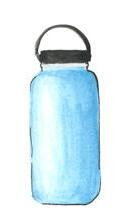
















written by MICAH BESSETTE
art by KATE STONE
When I walk around any public place recently, I see people carrying water bottles with them, whether it be the massive Stanley Cup, or just a generic reusable water bottle. I’ve always been a big advocate for drinking water, so I love seeing people carrying their water bottles, but how do you know which bottle is for you?
A water bottle can be a deeply personal thing, something you can keep for years and take with you on grand adventures. I used to have a water bottle that I took everywhere, and I would add stickers to it from people and places that I loved. One day I suddenly lost it, and I still miss it on occasion. A water bottle could also just be an afterthought, something you take with you to stay hydrated, but nothing more. It all depends on what type of person you are, and the water bottle you choose could reflect who you are and where you go.
I took a deeper look at what each type of water bottle says about a person, so that you can decide what bottle is best for you!
The classic Hydro Flask was a staple of the iconic VSCO girl in 2019. You are an environmentally conscious person who cares about the world and the people around you. You are likely tough and confident, and you inspire those around you while still maintaining your sass. You make do with what you have, and you make sure to protect the planet you’re living on. “I’ve had the same water bottle for three years and I’ve never felt the need to get another one,” says Siena Schaier (‘24) about her Hydro Flask. Look Out For: Scrunchies, metal straws, road trips, and beach days.
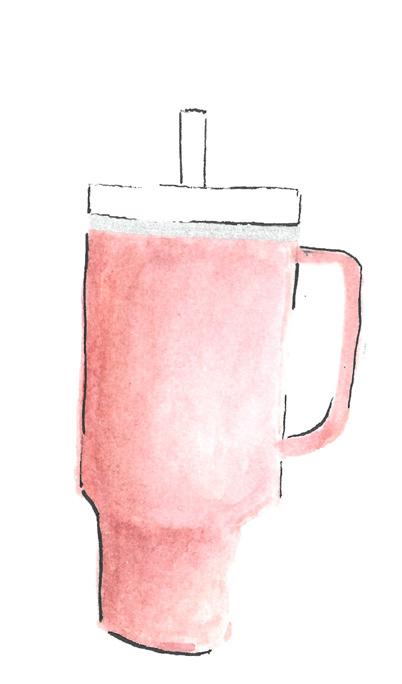











“I’m basic, and I’m very hydrated,” says Sarah Gallagher (‘24). Stanley has been around for over 100 years, and only recently has the Stanley cup become one of the most popular bottles out there. If you have a Stanley, you like to stay up with the trends and you’re always ahead of the game. You’re likely a very consistent person and you’re great at forming habits. You have a great sense of fashion, but you like to stay comfy until said fashion is needed. You love meeting new people, and you always have something interesting to add to conversations. Look Out For: Ugg slippers, city skylines, extensive Spotify playlists, and shopping sprees.
































One of the more recently popularized water bottles, Owalas are full of bright colors and handy features that makes this bottle perfect for artists and creatives alike. Your resourcefulness allows you to think outside the box, and you’ll often figure out new ways to see the world. Your creativity allows you to enjoy the small things in life, and your friends might describe you as “granola” or outdoorsy. Madeline Healey (‘25), an ORHS artist, explains how her Owala found her. “I was on a road trip, and I saw it in a Whole Foods. [...] I got it on my travels, and it’s been with me ever since... It’s also covered in clay.” Look Out For: Art supplies, spontaneous adventures, local coffee shops, and libraries.

You are an old soul. If it worked years ago, why change it now? You’re steady like a rock and never second guess your decisions. “My water bottle can withstand a drop off a cliff,” says Cayden Giordani (‘24). Your sense of adventure is unlimited, and you’re ready for whatever the world throws at you. You enjoy things like hiking and climbing, and it’s your dream to see the world. You’re likely a strong leader and your friends describe you as cool and confident. Although at times you may seem out of touch with your emotions, you’re secretly a very sensitive person. Look Out For: Early mornings, leather wallets, folk music, and hiking boots.

You’re an honest person who doesn’t feel the need to keep up with trends. You are probably bothered by dishonest, “fake” people, and you surround yourself with loyal friends. Your efficiency is impressive and you’re good at getting the job done. You are great at managing conflicts and your friends and peers have a deep trust to confide in you. “My last water bottle was broken, and I needed a new one, so I got the first one at the store,” says Riley Drapeau (‘24). Look Out For: At-home movie nights, singing in the car with the windows down, fuzzy blankets, and lakeside sunsets.

Whichever bottle you choose, remember you can always make it your own with stickers and other accessories. I hope this helped you choose the right bottle for you, so you can make a purchase confidently. Make sure you’re proud of the water bottle you’re using, and most importantly, remember to stay hydrated!





















written by MAEVE HICKOK and MIA BOYD
MAC AND CHEESE SYNOPSIS
hat is a synopsis you ask? It’s what people with a thesaurus use instead of summary. The synopsis of this article is simple. This is a food article, but not just any food article. It’s a food article that involves tasting, testing, recreating, and (the best ingredient) a dash of chaos. Mia and I (Chef Maeve) set out to answer the long contemplated but never ever answered question: make it or buy it?
Three foods were expertly tested and remade along our journey. The trifecta included mac and cheese, pizza, and french fries (in that order). And it wasn’t just any old mac and cheese, pizza, and fries but Oyster River High School student favorites. This line up included The Work’s mac and cheese, a slice of cheese from Durham House of Pizza (DHOP), and the local Ronnie’s Steakhouse french fries. If you just thought to yourself, I’ve never heard of Ronnie’s Steakhouse, this article’s comedic sophistication might be too much for you.
But why test these three foods specifically? The answer: postgame munchies. And what is the end goal, you ask? And I say, you have asked too many questions during this and you need to just let me explain.
Before writing this article, if you had asked me if I’d rather make a pizza for little to no cost or go out and buy a slice of DHOP for a little over 3 dollars, I would tell you DHOP on every day ending in Y. I would tell you the convenience and taste of DHOP is unmatched. But the real reason is that I have no idea how to use an oven. And another real fear, I make a pizza so good that it puts DHOP out of business. Because I’m always looking out for the little guy, like Ronnie’s Steakhouse, what would they do if I made a better french fry.
But I knew my bank account needed a break. I needed to unlock my inner Jeremy Allen White, and “Yes Chef” my way back into financial stability. Mia and I weren’t messing around in our recreations, almost everything was made from scratch. Starting with the Mac and Cheese.
Everyone knows if you want a good bowl of Mac and Cheese, The Works is the spot. For only 1,110 pennies you can
purchase that bowl of cheesy goodness. Old me would have said, “What a deal” but new me says, “Whatta rip off.” The cost of our Mac and Cheese is 0 pennies, because like many of you, the ingredient cabinet at your house is fair game. If you are a parent the cost might be a little more than zero, especially factoring in the cost of the house, the oven, the refrigerator, or the electricity that you would need to run this operation.
Mia and I first had to taste test for journalistic and research purposes. We found key ingredients: cheese, pasta, and various spices. Then, using only this basic knowledge we attempted to recreate these foods. The process and reviews can be found using the QR code, but the result, I kid you not, is better than The Works mac and cheese. It took just as much time as it would to go to The Works and order and cost us nothing. So, if you were reading this thinking, I was gonna say The Works is worth it, you were wrong.
Ingredients:
8 oz of pasta shells
2 tablespoons of salted butter
2 tablespoons of all purpose flour
¼ cup of white cheddar cheese
¼ cup of mozzarella cheese
Measure with heart Garlic and Onion Powder
Good Ol’ S&P
Breadcrumbs
Is there anything better than a good slice of pizza? World peace maybe, but there’s room for debate. I love pizza so much that it’s hard to articulate what it means to me. I think at this moment my blood pizza sauce content (BPSC for short) is at an all-time high coinciding with my Domino’s Rewards.
But enough about me, let’s talk pizza testing. We took inspiration from the great pizza reviewers of MOR’s past. Zach and Spencer’s Pizza Adventure was the OG pizza article written in 2017. We replicated their reviewing process to analyze the flavor profile of DHOP. Zach Leichtman (‘18), co-author of Zach and Spencer’s Pizza Adventure, commented on his process saying, “We were very serious in the way we went about testing, including all the angles of the cheese pull. . . We were very cautious not to have any bias.” Using the advice of MOR’s greats we did just the opposite. Our process is riddled with bias and tomfoolery.
Our analysis of the pizza included the sweetness of the tomato sauce, the crispiness of the crust, and enough cheese to put a lactose intolerant into a diaper. Using this knowledge and some help from Mia’s Italian ancestors. we crafted a pie so delectable Dave Portnoy would give it an 8 out of 10.
The only problem that occurred was a debate so heated it could have cooked the pizza. Pizza sauce versus pasta sauce. According to Mia Boyd’ardee, the two are in no way interchangeable. I say, “tomato tamato.”
Now, let’s get to the meat and potatoes, or should I say sauce and cheese. Was the pizza better than DHOP? The answer for me is no. I’m an honest critic and even though I have pizza bias, nothing beats takeout pizza. It’s impossible. But does the cost of DHOP justify it? That’s a hard no. Especially considering that we, amateur pizza makers, handmade the dough and sauce.
Ingredients:
2 and a ½ teaspoons of yeast
2 teaspoons of Sugar
Sprinkle of salt
2 cups of AP Flour (Cause it’s smart like that)
¾ Cup of Water
2 tablespoons of Olive Oil
2 tablespoons of Tomato paste
½ can of Tomato Sauce
Salt and Peppah
Crushed Red Pepper
Onion and Garlic powder to taste
What’s Up Brother?

I think if I ever go to flavor town, McDonald’s fries would be there. I’m salivating just thinking about them. Knowing this, recreation is a difficult task, but not one Mia and I shy away from. The first thing to analyze about any fry is the cut. Mcdonald’s goes with a classic shoestring but its “knot” hard to mess up. The average McDonald’s fry is 2.3 inches or 58.9 millimeters for you Europeans. This is important to know because as we selected potatoes we wanted consistency. Consistency in both fry size and distribution of crispiness. The process of french frying was slightly more complex than anticipated. It wasn’t as simple as throwing sliced potatoes into a fryer.
We first soaked our sliced fries in cold sugar water for an hour, then we boiled the fries, dried them off, and finally fried them in two rounds. This process took much longer than expected but the result was a fry just as tasty as one handed out of a drive through window. And for the price of a few potatoes, which is practically nothing, it was financially worth it. Although for the time it took, I’d freeze a few pre boiled batches.
Ingredients:
Potatoes
Salt

Exploring the opportunities available outside of the Oyster River High School walls.
written by guest contributor PAIGE STEHLE
Junior year is the year for college touring, and for Abby Trojan (’25), hours are spent in the car with her dad as they drive from the airport to a university. Alone in the car for a long period of time, Trojan’s father brings the conversation to the purpose of their travel: college.
This is a man who has known what he’s wanted to do since he was a young teenager working at his own father’s construction and real-estate company. He followed the straightforward path his father followed, and then married his wife, a teacher: another career with a straightforward path.
So, he is confused when his daughter tells him that she wants to go into archaeology and anthropology, which, at first thought, he only knows as “digging sh*t up.”
Trojan replies “Mm, little less Holy Grail with Nazis…more like, lab coat.”
Trojan knows she would not get this same reaction if she were to be a business major, or a teacher like her mom, or in construction like her dad. Most people, like her dad, can’t fathom this as a career. But Trojan knows her path: a four-year degree, a graduate degree, picking one of hundreds of subfields in archaeology while pursuing her Ph.D.,
But for Trojan to follow this more niche path, she’s aware that she needs to make sure that this is what she wants to do before she devotes large amounts of money and time to pursue it. The University of New Hampshire (UNH) Challenging Academically Talented Students (CATS) program, a non-de-

This is not an unfamiliar reaction to Trojan. Later on this college tour, she’s standing with other prospective students on the lawn of a campus, and the guide poses the classic ice- breaker question: “Where are you from? What’s your major?”
When Trojan tells them that she wants to major in archaeology, she gets a pause.
And then: “Oh, like Indiana Jones!”
gree program through UNH that allows high school students to take one free UNH class per year for credit, allows her to do this.
The CATS program is one of many options for Oyster River High School (ORHS) students to pursue academics outside of the ORHS Program of Studies. There’s also VLACS, the virtual learning platform, Career and Technical Education (CTE)
through the Dover and Somersworth high schools, and any learning activities categorized as an ELO, or Extended Learning Opportunity.
Allowing students to explore these options is important in many ways, one of which being saving time and money later in life. “It gives students a change to dive deeper into something they’re passionate about…they either become more passionate or figure out ‘this is not for me’,” says Sean Peschel, the ORHS ELO Coordinator.
For Trojan, she became even more passionate about archaeology, and she’s grateful she figured this out before she entered college. “I was really nervous that I was going to start college, plan out that I’m going to do archeology and anthropology, but it turns out that I’ll hate it,” she said. “I’d have spent all this money, all this time researching this perfect program, and it’s all for nothing,” Luckily, taking her CATS class cemented her passion for archaeology, and her path in it, when she enters college.
class through the CATS program, feels the same way. “Because it’s university-style, you have so much more freedom about your own education,” says Pant.

For Madalyn Now (‘25), her health science class through the Career Technical Education program at Dover High School also helps her save time and money. Now says, “You get to see if it’s something you’re interested in. There’s definitely some kids who are now having second thoughts, like ‘I don’t hate it, but it’s not something I want to do now.’” For herself personally, Now says, “I’m a very indecisive person, so picking a major in college is going to be very difficult for me to commit to something, but this showed me that this is where I want to go.”
These outside learning opportunities also grant students the
Unlike Trojan’s class, which consists of lectures two days a week, Pant’s was a weekly commitment: three days of lecture two days of recitation, in which she took quizzes and the TA went over the homework. She would go with a few seniors from ORHS in a carpool, and she thoroughly enjoyed her class, especially the freedom it granted.
“You’re able to take control of your own education—you know what’s important [to you] about it,” says Pant. If she didn’t have the option to take classes outside ORHS’s curriculum, she would have surpassed all the high school’s math classes by sophomore year.
Courtney Giroux (‘24), who’s taking an advanced study in linguistics, says “[My Advanced Study] is a thorough learning experience because I’m more engaged in the topic.”
These concepts of freedom and changing things up are prevalent in many of these outside learning opportunities because students have the freedom to create a learning experience that’s tailored to themselves. Through the ELO programs, they have a wide range of learning experiences to create for themselves.
“We have five different categories of ELOs at Oyster River: independent coursework, which is designing a course or experience that we don’t currently offer in the building…, Advanced Studies…building upon things we already have in the building…, internships, which are work-based learning experiences…., peer instructor, and while it’s not credit bearing,
freedom to have a taste of life after high school. Trojan enjoys the preview of the college environment she gets before she’s even in college. “I love the college environment so much because everyone’s just there to learn and have fun,” says Trojan.
Anika Pant (’25), who attended a multivariable calculus
also career exploration,” says Sean Peschel, the ELO coordinator.
One of these types of ELOs, Advanced Study, allows students to create a continuation of a class currently offered at ORHS. For example, if a student has completed both Acting
1 and 2, they could create an Acting 3. Or, if they completed Marine Biology, they could design a Marine Biology 2. The advanced study route is one that Giroux decided to pursue.
In the last few weeks of her linguistics class, Giroux wants nothing more than to continue the course. She loves everything about it—her teacher, her classmates who are uncharacteristically willing to engage in in-depth conversations about topics within linguistics, and of course the subject in general.
She thinks, if there were to be a second linguistics class at the school, she’d be in academic heaven.
“Linguistics 2! Linguistics 2!” Giroux chants at her friends in the comforting atmosphere of Mr. Kelly’s room.
But no one else seems to be on board.
So, Giroux’s next best option to continue learning about linguistics was creating an Advanced Study ELO on linguistics, with the help of Mr. Kelly and Sean Peschel, the ELO coordinator.
Giroux customized her ELO to continue to study topics of language and thought, phonemes, and language acquisition. Customization is one of the many important components of ELOS. “[ELOs} are not only individualized, personalized,
and Somersworth provide those classes for students in their surrounding areas, through the Career Technical Education (CTE) program.
Now is currently taking a health science course at Dover High school, which prepares her to become a licensed nursing assistant (LNA), and she loves it.
Every day, after being bussed over to DHS, Now walks into a room that’s about half Oyster River students, half Dover students, and a sprinkling of students from other schools. While of course the class is still a class (complete with quizzes, workbooks, etc.), there’s also plenty of unconventional activities in Now’s health science class. She’s done things from taking classmates’ vital signs to spending 60 clinical hours working in nursing homes.
Of course, there’s less-pleasant times. For instance, Now remembers a day where one resident projectile vomited everywhere in the dining room, and as soon as the students began to clean it up, two more residents did the same! But Now doesn’t mind these moments, because the bonds with residents and the satisfaction she gains from helping these people are completely worth it. “You can see that they need it, and some of them you can tell appreciate it,” says Now.
“You’reabletotakecontrolofyourowneducation—youknowwhat’s important[toyou]aboutit.”-AnikaPant(‘25)
and customizable, but they also have exposure, exploration, and experience,” says Peschel.
Giroux has weekly meetings with Kelly to show him what she’s done towards her ELO: presentations, mini-tests, research, and more. “I run it like a mini class where I’m the only student,” says Giroux.
Pant also had a class of one her sophomore year. She created an independent study in which she took AP Calculus BC on her own, using the same resources that the actual class is provided with.
Classes based on current ones offered at ORHS aren’t the only type of independent studies, though. Trojan is also pursuing an independent study alongside her CATS class, but it’s one that’s much more out-of-the-box.
She’s building up the Women in STEAM and DEIJ clubs as part of her ELO. “I am interviewing people, creating events, reaching out to people, emailing, and all that, I’m basically learning communication and business management skills,” says Trojan.
These “classes of one” are helpful for students who have no other option to learn the specific thing they’d like to learn. However, sometimes the class one wants to pursue exists, just at a different school. For those who have more technical or medical passions, high schools in towns such as Dover
The meaning and experiences Now gained from her CTE classes are just a few of the benefits she gained from the course. Now was also exposed to networking connections through her CTE class, such as internships and jobs that are pretty much guaranteed to her once she’s licensed as an LNA when her health science class ends.
It’s not just CTE classes that expand students’ opportunities available to them, though. Trojan has begun doing independent coursework with her professor and was introduced to careers in archaeology through UNH’s anthropology and archaeology fair. She’s now interning under her professor at the Strawberry Banke Museum in Portsmouth, and is learning, in real time, the methods of digging, researching and restoration components of archaeology
These sorts of opportunities, along with the meaning, exploration, and enjoyment students get from academics outside the ORHS Program of Studies, are crucial for students to be provided with. It allows them to become engaged in the world, because they love what they do. “The true outcome of school should be creating better, engaged citizens of the world,” says Peschel.

written by AMELIA RURY



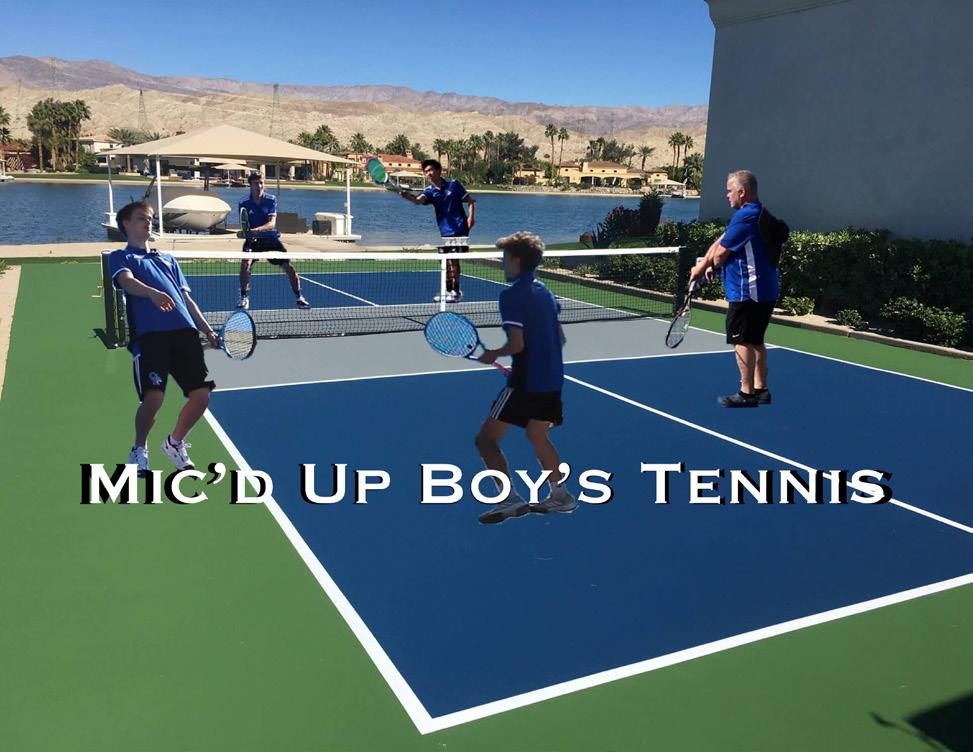



written by TALON OUELLETTE AND MAIRTIN SWEETMAN images courtesy of HAZEL STASKO
It was September of 1996. Not knowing what the day had in store, Michael Troy pulled into the school’s parking lot in his Chevy Silverado. As he turned the key to shut off the truck, the constant whirr of the engine was replaced with silence.
Troy, the new woodshop teacher at Oyster River High
bonded over the struggles of settling into the new job.
Soon enough, the first bell had rung, and students began to enter Troy’s classroom. Troy didn’t exactly have a plan cut out for him, as he was given the job of creating the woodshop curriculum from scratch. He figured he’d start by asking stu-

School (ORHS), was ready to start a new chapter in his previously chaotic life. He made his way into his new classroom, and was hit with the familiar smell of sawdust as he opened the door. He set his hot coffee down on his desk before taking
dents what they wanted to build and what they were interested in learning. With this information, he shaped the classes into what they are today through trial and error.
The first day came to an end, and Troy left the building with
“Youmessup,hedoesn’tcare.Hejustwantsyoutokeeppersevering”
a seat and looking around. Little did he know that within these walls he would impact the lives of thousands of students over the next three decades. At the time, changing lives was the last thing on Troy’s mind. He was simply excited to see what the day would bring.
After hearing a knock at the door, Troy sprung up and looked over to see the first of many new faces. The man greeted Troy with a smile and introduced himself as Lawrence, the resident art teacher at ORHS. The two quickly hit it off and
a smile on his face. To top it all off, Troy was able to simply return home and see his family (something he was unable to do at his previous jobs, since he traveled frequently). Troy was happy with his new job and looked forward to this new chapter in his life.
Now, Troy is one of the veterans of the Oyster River staff, and his name is known throughout the district. Simply put,
he’s a character and someone that any student at Oyster River should get to know.
This year marks Troy’s twenty-eighth year at Oyster River High School. After previously working as a contractor and with data communications, he found himself struggling to balance life between work and home with his three children.
Rosi, a current art teacher, and the previously mentioned (and now retired) Mr. Lawrence from the art department.
Troy said he enjoyed “watching their families grow, and getting to find true friendship here at school with coworkers that I do believe are lifelong friendships.”
LaForce commented on how he and Troy met, saying they
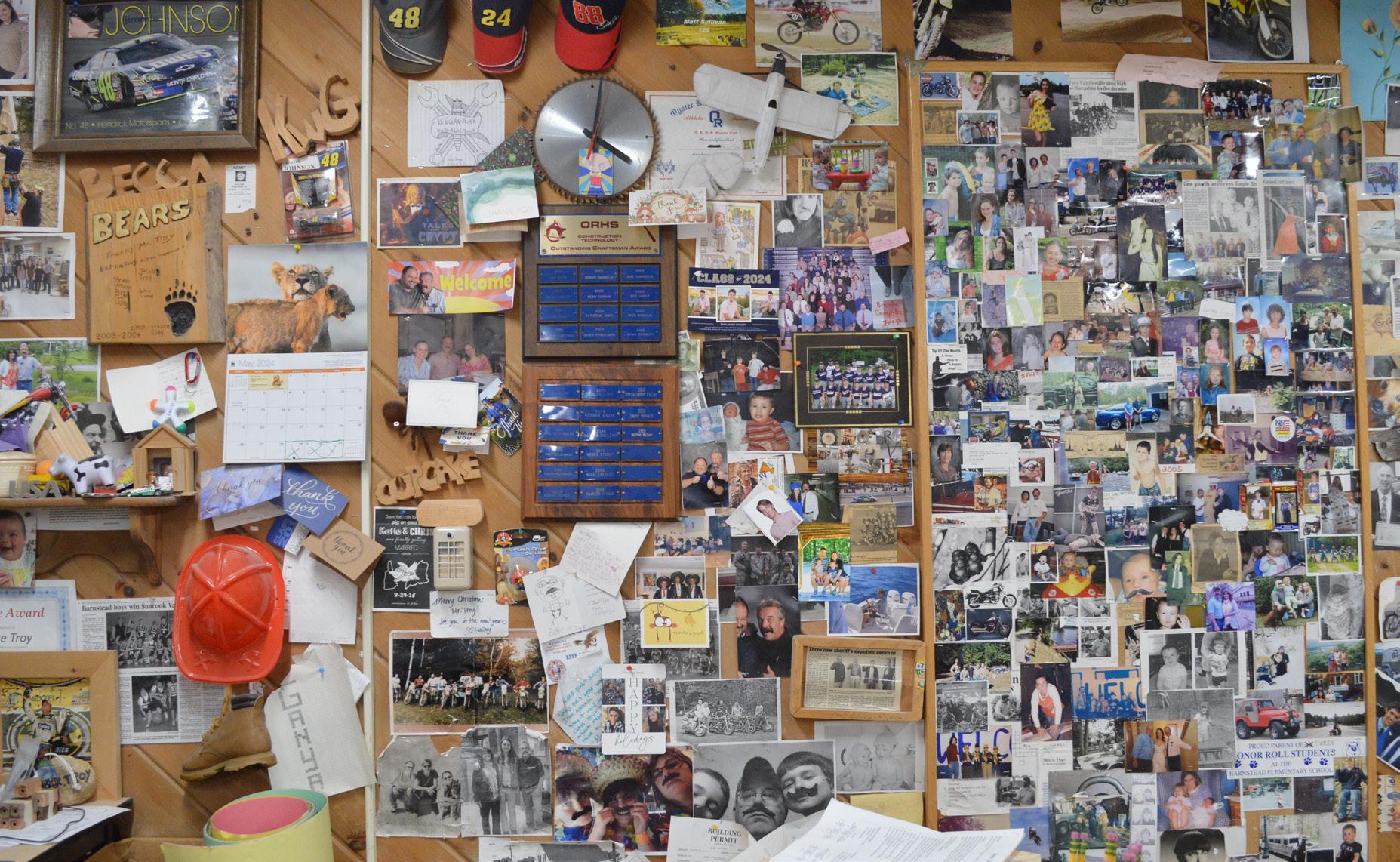
He had always wanted to work as a teacher and got the chance to settle down and do so at Oyster River.
Through the years, Troy made good friends with some of his fellow teachers, got up to some shenanigans around the building, and has had the opportunity to watch students grow and learn during and after their high school years. He’s built a reputation as someone who’s always ready to crack a joke, but can be serious when the time calls. He’s left quite an impact on students and teachers alike here at Oyster River, and it isn’t hard to see.
hit it off “pretty early on. Then we got along famously well after that.” In fact, LaForce, Troy, and Lawrence became such good friends they became known as “The Three Amigos.”
“He’s a human before he’s a teacher and he relates to his students like humans first.”
It only makes sense that the people Troy got along best with had a similar sense of humor. This would lead to pranks being pulled by not only Troy alone, but with the help of some of his fellow teachers and students.
One of Troy’s favorite parts of his job at Oyster River is seeing his students grow into independent young men and women and seeing them solve problems by themselves through trial and error. In regards to how far a student can come in only a semester, Troy said “[Students] have never worked the machines, and they’re leaving here with chairs and compound angle stools.”
On top of getting to witness students succeed through hard work and effort, Troy has also had the opportunity to make lifelong friends with people like Mr. Whalen from the math department, Mr. LaForce from the music department, Ms.
As Ms. Rosi walked her class outside into the woods, suddenly there was a loud pop followed by a thud as something hit the ground. Rosi, who was still a first-year teacher at the time, believed the sound to be a gunshot. She silently arranged her kids and the class hurried to get back inside. About halfway back to the building, Rosi noticed something strange. Standing in front of her was Mike Troy and a group of students hysterically laughing with potato guns in hand, firing them into the forest where Rosi’s class had come from.
Years later, inside the shop, was the school’s gator: a golf-cart type vehicle used to navigate the athletic fields. It sat in the back of the classroom, due to the original garage being burnt down. Troy and Whalen, seeing the gator unattended,
“Getting to find true friendship here at school with coworkers that I do believe are lifelong friendships.”
devised a plan. They gathered some survey equipment, put on some hardhats, and hopped on the gator. They drove their way to the front of the building, and began setting up the survey equipment, all right outside of the principal’s office. Inside the office, the principal was meeting with the architect tasked with rebuilding a section of the building. Together, they witnessed the whole thing. As Troy and Whalen continued their charade, Troy held a blueprint in his hands, looking at it with a confused expression. Whalen walked over, flipped the blueprint, and Troy made a face of revelation. The blueprint was upside down, meaning they had to be on the other side of the building. They packed up their equipment and fled the scene. “We got spoken to by the company, but it was a lot of fun,” said Whalen.
As Troy spent years at Oyster River, his reputation for shenanigans began to grow. He was always up to something, but don’t let his mischievous demeanor fool you. Behind the rough exterior, dry sarcasm, and ever-so-famous mustache sits a man who cares about his students and wants to see them succeed more than anything.
“Even when it came to small things around the building, Troy was there to help. He’d like to keep a low profile, but he would do a lot of stuff behind the scenes,” said LaForce.
This willingness to help is reflected in his teaching as well. “You mess up, he doesn’t care. He just wants you to keep persevering,” said Jack Charleston (’27)
Many students come into Troy’s classes with little knowledge of woodworking, but Troy still does his best to make it accessible and doable for anyone.
Olivia Mueller (’24), a new face in the shop this year, said “He teaches his kids how to use the different machines based off of what they already know and how confident they are. There’s no pressure at all.”
“He’s a human before he’s a teacher and he relates to his students like humans first.” said Rosi, explaining that Troy’s down to earth personality and humor is what makes him a truly great teacher.
Although woodworking is Troy’s main area of expertise, he also teaches his students valuable life lessons. “[Troy has] taught us a lot of respect and how to interact with other people,” said Casey Pirtle (‘25). “Even though I didn’t have his class this year, I like to visit whenever I can because he gives good advice,” Pirtle continued.
Many are sad to see Troy go, but all are thankful to have worked alongside or to have been taught by him.
The B3 period begins, and Troy has a Construction Technology class. He stands at the door of his classroom, welcoming each student as they enter. The bell rings, and he makes his way to his desk. He quickly takes attendance and asks the students about how they spent their April vacation. The students share, and he cracks jokes along the way.
Once the conversation finishes, the students grab their safety glasses and head into the shop. A few students notice Troy’s motorcycle in the back of the shop and can’t help but ask about it. Troy shares an old story of a motorcycle ride with one of his sons that ended with his kid on fire (he was not injured), and the students and Troy all share a laugh. The students then get to work, and Troy makes his way around the shop, helping students as needed. He notices a shortage of wall studs needed for the model houses the students are building. A student and him spend some time cutting enough studs for the class to use, all while chatting about cars, motorcycles, and anything else that comes up.
Soon enough, it comes time to clean up the shop. Troy, with the help of his students, picks up all the wooden scraps around the room, puts away all the stray tools, and goes back into the classroom. He goes over the plans going forward in the class, and his students leave for lunch. With the classroom to himself once again, he can’t help but think of the years ahead. He’ll miss the job, the coworkers, the students, and the high school altogether. But, for now, there’s nothing to do but enjoy the last month as much as possible.

How Oyster River High School students spent their half-day.
written by DELANEY NADEAU

On Monday, April 8th, Oyster River students were thanking the stars for an early dismissal as the sun and the mood aligned in totality for the first time in over a decade.
The Oyster River School District had an early release on the 8th for a once in a lifetime opportunity.
Many students traveled north to see the 2024 Solar Eclipse in its totality.
A few of those who went to see the global phenomenon in its totality had plenty to share with those who stayed local. Some students just enjoyed having a short day of school, while others didn’t go to school at all in order to experience this once in a lifetime event enduring traffic and crowds.
Keira Johnson (‘24) who traveled to Lancaster, NH, discussed her experience watching the total eclipse saying, “It got so dark that you could see stars in the sky and you could also see all the automatic street lights turned on. It was cool to see that and then, [when] it actually happened, it just looked like there was a white light with just a hole in the middle.”
Laura Boughton (‘26) watched the eclipse at Little River Park. “It was kind of uneventful. Everybody was so excited, but it just got a little dark.”
That was the trend of many students who watched from around here though some wished they’d seen it in totality.
Totality reached New Hampshire just north of Ber-
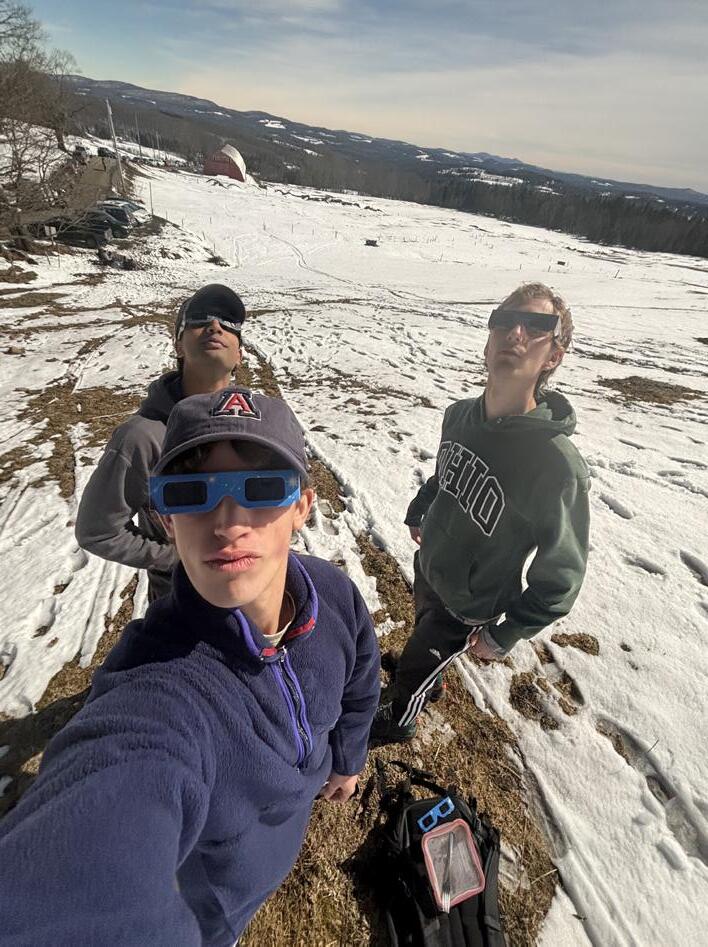
lin. However, some students traveled all the way to Canada to watch the eclipse, like Grace Kasper (‘25). She highlighted her experience saying, “We went to a super cute little town where we ended up watching it over a little pond, and it was super peaceful and nice.”
The eclipse was a “surreal” experience for some, including Saketh Kantipudi (‘24), who skipped school and traveled to a hill in Vermont with two of his friends. Aside from the actual scientific experience of the eclipse, which he thought was fascinating, Kantipudi had a more personal experience. “The drive up was pretty fun—we were talking—and it gave us the perspective that sometimes you have to sit through five hours of traffic for something good.”

Many other students who traveled to see the eclipse also

highlighted the amount of traffic they got stuck in on the way home. “It took us like three and a half hours to get back [from Lancaster, NH], which isn’t that bad compared to other people,” Johnson said.
One of those other people she’s referring to is Kasper, who spent 13 hours in traffic. “The traffic after was the worst I’ve ever seen,” she began. “There were just so many people, it was crazy, but it was also the calmest traffic I’ve ever seen. Everyone was so sweet, and we heard not a single honk.”
Everyone who saw the eclipse in its totality thought it was an incredible experience but many of those who stayed at home, including Boughton, said “I would be fine if I didn’t [watch it].”
Addie Toye (‘24) watched the eclipse from her house in Durham and said, “I didn’t realize it wasn’t going to get fully dark here.”
A common theme from not only those who traveled to totality, but also those who stayed local, was the level of excitement and community that emerged from this shared experience. It’s not often that we, as a community, come together and all pause to look at the same thing, but that’s exactly what happened. The next total solar eclipse isn’t until August 23, 2044.
written by IAN HILFIKER

The Strafford County guitar community has taken hit after hit in recent years. Many longtime local guitar stores are closing, and musicians are finding there are less and less honest, down-toearth community stores to frequent. But, not if Scot Villeneuve has anything to do about it.
It has been roughly six months since the opening day of Villeneuve’s latest project: Barrington, New Hampshire’s very own guitar store, BigHit Guitars. What started out as just a way to minimize his extensive collection of high-end American-made guitars, in time, has become a community staple for local musicians.
BigHit Guitars was never intended to be such a big hit. Villeneuve had spent the majority of his adult life in media, and has built a successful media and marketing business, BigHit Media. While his media business has seen elevated levels of success over the years, being contracted to do work for people like Turbocam and Granite State Glass, his passion has always lied with music and, more specifically, guitar.
The guitar branch of his store started with humble origins. “I originally started to sell-down my personal collection of 12 guitars. I thought I had too many… and [now] I have sold 96 gui-
tars,” remarked Villeneuve.
His friends noticed these changes too. “I thought we were supposed to downsize not upsize! And one thing led to another and then the “BigHit Guitars” sign went up,” said Rick Beary, longtime friend of Villeneuve.
Villeneuve has always been connected to guitars saying, “I have been passionate about guitars most of my life. I started playing when I was a teenager and I have always been fascinated by guitar music.” However, the guitar stores he went to when he was young were never remotely accommodating to young people. “I felt like, you know, I was bothering the guys there. Sure, it was true. I didn’t have enough money to buy that guitar, but I was saving up for it!”
Villeneuve has never let that experience of feeling unwelcome leave him. “I draw from that experience [when] crafting the experience at BigHit Guitars, because I want it to be welcoming,” said Villeneuve.
This welcoming environment is felt by his customers, including Logan Jabour (‘24), a frequent customer of BigHit Guitars. “It feels a lot more local and personal. Almost everything he sells has stories too it. Plus, [Villeneuve’s] a cool guy,
and it feels very casual in his store,” said Jabour.
Villeneuve has also put a lot of time into making sure young people never feel unwelcome in his store. “Even though [Villeneuve] knows I am far too broke to buy a guitar right now, he still welcomes me in and treats me with the same respect he treats everyone else,” said Jayden Madison, a seventeen-year-old guitarist.
There is something to be said about a comfortable environment being better for business. While Villeneuve’s own personal values may play a key role in the way he shapes his business, it is impossible to deny that it does help foster a great business environment. In the store’s short six months of operation, Villeneuve has already sold over 100 guitars, along with several other sales of things like amplifiers and pedals.
“I see a lot of progress being made, and a lot of positivity being spread into the community from this store,” remarked Richard Shepherd, a close friend of Villeneuve.
Villeneuve also commented on the fact that many of Strafford County’s most beloved guitar stores have closed in recent years, which is now having a positive impact on his business. “Leading up to starting, or opening the store, some long-standing area stores closed for various reasons. Some went out of business, some for retirement reasons, and it left a gap in the market.”
One of the many benefits the business has brought him is the ability to possess a multitude of rare and quality guitars. These help to draw in even more people and serve as beautiful focal points throughout the store.
The store does not appear to be slowing down, and Villeneuve expects to break 150 sales by the summer.

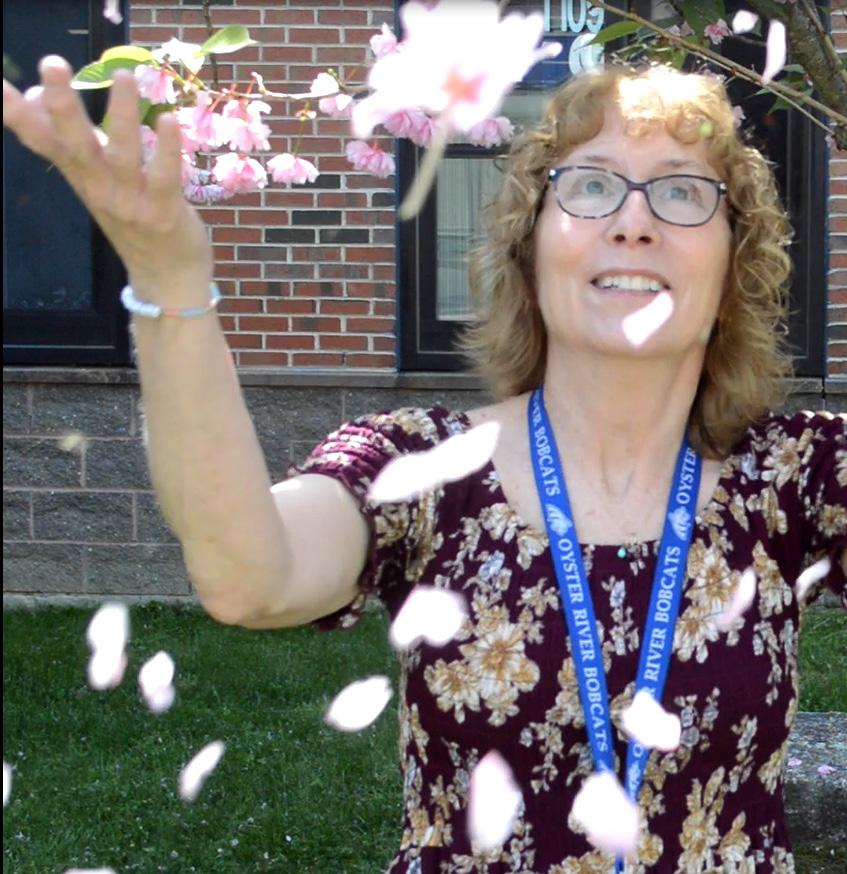
Barbara Milliken has been the heart of ORCSD’s language program for 31 years, and this year she will be joining her husband and ORHS’s former vice principal Mark Milliken in retirement.





